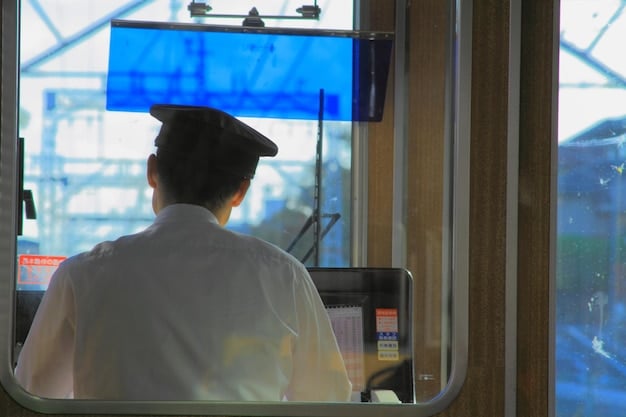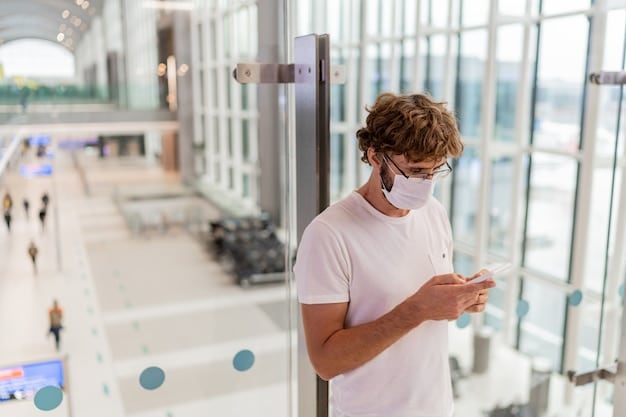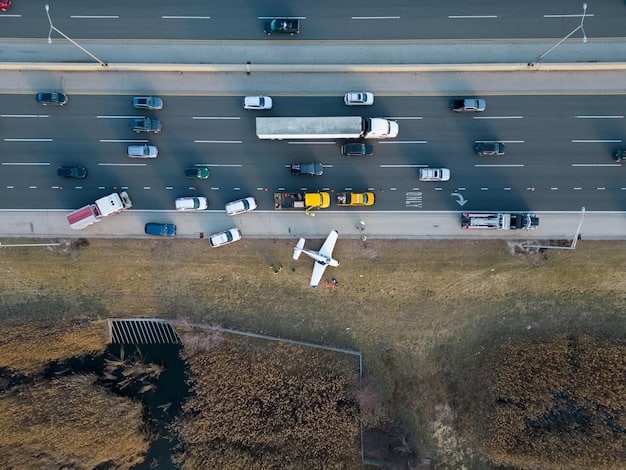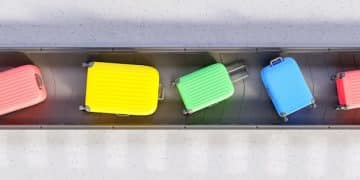US Border Security: What Travelers Need to Know Now

Navigating the evolving landscape of travel requires understanding the new security measures at US border crossings: what travelers should prepare for, ensuring a smoother, more efficient, and compliant journey for all.
Travelers preparing for international journeys often find themselves wondering about the ever-changing landscape of border security. Understanding the new security measures at US border crossings: what travelers should prepare for is no longer just a recommendation but a necessity. This comprehensive overview offers critical insights into the latest protocols, technological advancements, and practical advice to ensure a seamless entry or exit, helping you navigate these changes with confidence and ease.
Understanding the Shifting Landscape of Border Security
Border security is a dynamic field, constantly evolving to address new threats and adapt to technological advancements. For travelers entering or exiting the United States, keeping abreast of these changes is paramount. The goal of these new measures is multifaceted: to enhance national security, streamline legitimate travel, and combat illegal activities. This shift impacts everything from document requirements to the methods officers use to screen individuals and goods.
The U.S. government, through agencies like Customs and Border Protection (CBP) and the Department of Homeland Security (DHS), continuously assesses global risks and recalibrates its strategies. This proactive approach means that what was standard procedure a few years ago might have been updated or replaced by more sophisticated methods today. Travelers must understand that these aren’t arbitrary changes but rather calculated responses to a complex global environment.
The Digital Transformation of Border Control
One of the most significant shifts has been the integration of digital technologies. Manual checks are increasingly supplemented or replaced by automated systems, leading to faster processing times but also requiring travelers to be more meticulous with their digital footprint. Electronic travel authorizations and biometric data collection are now commonplace.
- Biometric Scans: Facial recognition and fingerprint scans are becoming standard at many ports of entry. This data helps confirm identity and cross-reference with watchlists, enhancing security layers.
- Advanced Passenger Information System (APIS): Airlines provide passenger data to CBP before flights depart, allowing pre-screening and flagging of potential concerns.
- Mobile Passport Control (MPC): This app-based system allows eligible travelers to submit passport and declaration information digitally, often leading to significantly shorter wait times at designated checkpoints.
These digital tools emphasize efficiency and a data-driven approach to security. While they speed up the process for many, they also place a greater responsibility on travelers to provide accurate and up-to-date information. Errors or omissions in digital submissions can lead to delays or further scrutiny.
The evolving nature of threats, from terrorism to sophisticated smuggling operations, necessitates a continuous evolution in security measures. Travelers are, in essence, partners in this security effort; their cooperation and preparedness contribute directly to the efficiency and integrity of border operations. Understanding the “why” behind these measures can help demystify the process and encourage compliance, leading to a smoother experience for everyone involved.
Ultimately, these security enhancements aim to create a safer travel ecosystem. While they might occasionally introduce new steps or requirements for travelers, their fundamental purpose is to protect national borders and ensure the safety of citizens and visitors alike. Being informed and prepared is the best way to navigate this modern security landscape.
Enhanced Document Verification and Biometric Screening
The cornerstone of modern border security lies in rigorous document verification and the increasing reliance on biometric screening. These measures are designed to confirm a traveler’s identity, detect fraudulent documents, and cross-reference individuals against various security databases. The precision and speed of these checks have improved dramatically, making it crucial for travelers to present valid and current identification.
U.S. border officials are equipped with advanced technology capable of detecting even subtle alterations in travel documents. This includes sophisticated scanners that can read embedded chips in e-passports, verify watermarks, and identify discrepancies that might be invisible to the naked eye. Travelers should ensure their passports are in excellent condition, without any tears, water damage, or unofficial markings, as these can trigger additional scrutiny and delays.
Biometric Data: Your Digital Fingerprint at the Border
Biometrics have transformed how identity is verified at border crossings. Facial recognition, fingerprint scans, and iris scans are becoming standard procedures, especially for non-U.S. citizens. This data is collected and compared against databases of known travelers, visa applications, and even criminal watchlists. The goal is to create a unique digital identity for each traveler, making it significantly harder for imposters to cross borders.
- Facial Recognition Technology: At many U.S. airports and land border crossings, travelers may undergo facial recognition scans. This compares a live image of the traveler to the photo on their e-passport or visa.
- Fingerprint Scans: Predominantly used for non-U.S. citizens, fingerprint scans help verify identity and ensure individuals are not attempting to enter the country under false pretenses or with a history of immigration violations.
- Data Matching: Beyond simple identification, biometric data is used in conjunction with Advanced Passenger Information to ensure the person presenting the document is indeed the person it belongs to.
The implementation of these biometric measures is not only about security but also about efficiency. Once a traveler’s biometric data is accurately captured and matched, future cross-border movements can potentially be expedited. However, initial encounters with these systems might take slightly longer as the technology captures and processes the necessary information.
Travelers should be aware that refusal to comply with biometric collection, if required for their entry status, can lead to denial of entry. It is a mandatory part of the screening process for many categories of visitors. Preparing for these scans by removing hats, glasses, or anything that obstructs facial features, and ensuring hands are clean for fingerprinting, can help facilitate a smoother process.

In essence, enhanced document verification and biometric screening represent a significant leap in border security capabilities. They provide a robust layer of protection by linking physical presence with digital identity. Travelers should anticipate these procedures and ensure all their travel documents are not only valid but also pristine, to avoid any unintended complications during their journey.
Increased Scrutiny of Electronic Devices and Digital Footprint
The digital age has brought unprecedented connectivity but also new vectors for security concerns. As a result, U.S. border officials are increasingly scrutinizing electronic devices and travelers’ digital footprints. This measure aims to detect illicit content, identify potential threats, and verify information provided by travelers. It’s a significant shift from purely physical inspections and requires travelers to be mindful of their digital presence.
Customs and Border Protection (CBP) officers have the authority to examine electronic devices, including phones, laptops, and tablets, when entering or exiting the U.S. This authority is primarily exercised when there is a reasonable suspicion of illegal activity or based on national security objectives. While general statistics suggest these searches are relatively rare in proportion to the total number of travelers, their possibility necessitates preparedness.
What Constitutes a “Digital Footprint”?
A traveler’s digital footprint extends beyond the content on their immediate devices. It includes activity on social media, email communications, and even cloud-stored data. While officers might not have direct access to all cloud data without specific warrants or consent, the content visible on devices can provide grounds for further inquiry. The rationale is to ensure individuals are not involved in activities that could pose a risk to national security or violate U.S. laws.
- Device Content Review: Officers may request to view photos, videos, messages, and internet browsing history. Travelers should ensure no content on their devices could be misinterpreted or raise undue suspicion.
- Social Media Scrutiny: While not a direct “search” of private accounts, publicly available social media profiles can be reviewed. Content that suggests extremist views or intentions to violate visa terms could lead to questioning.
- Data Integrity: Deleting apps or content right before crossing the border can be viewed suspiciously, as it might indicate an attempt to conceal information.
To prepare for potential scrutiny, travelers should review the content on their devices, especially if traveling for sensitive purposes. Consider carrying only essential information on devices, and if business-sensitive data is present, consult with your employer about secure data handling protocols for international travel. Some advise backing up sensitive data and wiping devices before travel, then restoring data upon return, though this might not be practical for all.
It’s important to understand the legal bounds of these searches. U.S. citizens generally have more protections than non-citizens regarding digital device searches, but the specifics can be complex and are often subject to ongoing legal interpretations. When faced with such a request, remaining calm, cooperative, and truthful is generally the best approach. If concerned, travelers can politely inquire about the reason for the search or request to speak with a supervisor.
The increased focus on electronic devices represents a modern adaptation of border security to the digital age. It’s a reminder that every aspect of a traveler’s profile, including their digital one, can be part of the security assessment. Being aware of these powers and preparing your digital presence accordingly can help ensure a smoother border crossing experience.
Health Screening Protocols and Public Health Preparedness
The global pandemic underscored the critical role of health screening protocols and public health preparedness at international borders. While the immediate intensity of COVID-19-related measures has largely subsided, the infrastructure and awareness gained remain. Future health crises, or even localized outbreaks, could trigger new or reinstated protocols. Travelers must stay informed about current health requirements to avoid unexpected delays or denial of entry.
U.S. border agencies, in collaboration with the Centers for Disease Control and Prevention (CDC), have established frameworks for responding to public health emergencies. This means that measures such as health declarations, proof of vaccination, or even rapid testing could be reinstated with little notice if a significant health threat emerges. The focus is on preventing the spread of communicable diseases and protecting public health within the U.S.
Key Health Measures to Monitor
Even in periods of low health risk, travelers should be aware of a few enduring or potentially re-emerging protocols:
- Traveler Health Declarations: These forms, often digital, require travelers to declare recent travel history, symptoms, and potential exposure to illnesses. While not always mandatory, they can be quickly implemented.
- Vaccination Requirements: For certain visas or entry types, proof of vaccination against specific diseases might be a standing requirement. During health crises, additional vaccine mandates could apply.
- Thermal Screening and Symptom Checks: Although less common now, airports and border crossings can re-implement thermal scanners or conduct visual symptom checks for travelers presenting signs of illness.
The key to navigating health screenings is vigilance. Before planning any international travel and immediately before departure, check the official websites of the CDC and CBP for the latest health advisories and requirements for entry into the U.S. This includes specific guidelines related to any current global health concerns or region-specific outbreaks that might affect your travel. Airlines and cruise lines are also excellent sources of information, as they must comply with these protocols.
Travelers who feel unwell before or during their journey should consider postponing travel or seeking medical advice. Attempting to travel while exhibiting symptoms of a serious communicable disease can lead to isolation, mandatory testing, and significant disruption to travel plans. Being transparent about health concerns, if required, and cooperating with health officials is crucial for both personal well-being and public safety.
The pandemic served as a stark reminder of how rapidly global health landscapes can change and necessitate border adjustments. By staying informed and being prepared for potential health-related screenings or requirements, travelers can contribute to a safer environment for everyone and ensure a smoother passage.
Pre-Travel Programs and Trusted Traveler Options
For frequent travelers, especially business professionals or those with family abroad, navigating enhanced security measures can consume significant time and introduce stress. Recognizing this, the U.S. government offers several pre-travel programs designed to expedite border crossings for pre-approved, low-risk individuals. Enrolling in these “Trusted Traveler” programs can dramatically reduce wait times and streamline the entire process, yet many travelers are unaware of their benefits or eligibility.
These programs represent a calculated trade-off: in exchange for a thorough background check and personal interview, travelers gain access to expedited processing lanes at airports and land border crossings. This enhances security by allowing CBP to focus resources on higher-risk individuals, while rewarding compliant travelers with efficiency.
Overview of Key Trusted Traveler Programs:
Each program caters to different travel needs, but all aim to provide a more efficient experience.
- TSA PreCheck®: Primarily for domestic U.S. air travel, this program allows enrolled passengers to experience expedited security screening at airports. This means no need to remove shoes, laptops, liquids, belts, or light jackets.
- Global Entry: This is the premier program for international air travel. Global Entry members can use automated kiosks at select U.S. airports to clear customs and immigration, bypassing traditional lines. It also includes TSA PreCheck® benefits.
- NEXUS: Designed for frequent travelers between the U.S. and Canada, NEXUS offers expedited processing at designated border crossings by land, air, and sea.
- SENTRI: Similar to NEXUS but for the U.S.-Mexico border, SENTRI provides expedited Customs and Border Protection processing for pre-approved travelers entering the U.S. from Mexico.
- FAST: (Free and Secure Trade) This program caters specifically to commercial truck drivers involved in cross-border trade with Canada or Mexico, ensuring faster processing of legitimate cargo.
Applying for these programs involves an online application, a non-refundable fee, a background check, and an in-person interview at an enrollment center. The entire process can take several weeks to months, so prospective applicants should plan well in advance of their travel needs. Eligibility criteria vary by program, often requiring U.S. citizenship, lawful permanent residency, or citizenship of specific eligible countries.
The benefits of these programs extend beyond simply saving time. They reduce the unpredictability of border crossings, allowing travelers to plan their schedules with more certainty. While enrollment requires an initial investment of time and money, the long-term gains in convenience and reduced travel stress are often cited as significant advantages by members.
For those seeking to optimize their travel experience under the new security landscape, exploring and enrolling in a suitable Trusted Traveler program is highly recommended. It offers a proactive solution to navigating the heightened scrutiny and contributes to a smoother overall journey.
Navigating Land Border Crossings: Specific Considerations
While air travel often receives the most attention regarding security measures, land border crossings, particularly with Canada and Mexico, represent a significant portion of international movement into and out of the U.S. These crossings have their own unique set of considerations and challenges, distinct from air travel. Understanding these specifics is vital for travelers planning to enter the U.S. by road.
The volume of traffic, diverse modes of transport (personal vehicles, commercial trucks, pedestrians), and local commuter patterns contribute to the complexity of land border operations. Security measures here focus on vehicle inspections, identity verification, and interdiction of illegal goods or individuals attempting to bypass official entry points.
Key Differences and Requirements for Land Travelers
Land border crossings often involve different technologies and procedures compared to airports:
- WHTI-Compliant Documents: The Western Hemisphere Travel Initiative (WHTI) mandates specific documents for U.S. citizens and Canadian citizens re-entering the U.S. by land or sea. This includes passports, enhanced driver’s licenses (EDLs), trusted traveler cards (NEXUS, SENTRI, FAST), or enhanced tribal cards. Regular driver’s licenses are usually not sufficient for re-entry.
- Vehicle Inspections: All vehicles crossing the border are subject to inspection. This can range from a quick visual check to more thorough examinations involving X-ray technology, canines, or physical searches. Drivers should be prepared to open trunks, glove compartments, and present vehicle registration.
- Declaration of Goods: Similar to air travel, all goods being imported must be declared. This includes agricultural products, firearms, and cash exceeding $10,000 USD. Failure to declare can result in fines, seizure of goods, or even arrest.
Wait times at land border crossings can fluctuate significantly based on time of day, holiday periods, and unforeseen events. Travelers are advised to check official CBP wait-time tools online before heading to the border. Planning travel during off-peak hours can often yield a quicker passage.
For those frequently crossing, enrolling in programs like NEXUS or SENTRI is highly beneficial. These programs offer dedicated, expedited lanes, significantly reducing wait times for pre-approved travelers and their vehicles. The application process is thorough, including background checks and vehicle inspections, but the convenience gained is substantial.
Drivers should ensure all occupants of the vehicle have appropriate identification and are prepared to answer questions from the border officer. Honesty and cooperation are paramount. Any attempts to conceal information or goods can lead to severe penalties, including seizure of the vehicle and denial of entry.

Navigating land border crossings requires similar diligence to air travel but with an added focus on vehicle readiness and specific document requirements. Being prepared, understanding the rules, and planning ahead are the best strategies for a smooth and efficient experience.
Preparing for the Unexpected: Advice for All Travelers
Despite all preparations, travel, especially international travel, can present unexpected challenges. New security measures, while designed for efficiency, can sometimes lead to unforeseen delays or additional scrutiny. Being prepared for the unexpected is as crucial as understanding the rules themselves. This involves a mindset of patience, cooperation, and proactive communication.
Border Security measures are constantly evolving, and while this article covers the most prominent aspects, new directives or technologies can emerge. Travelers should always consult official government sources (like CBP.gov and DHS.gov) immediately before their journey for the very latest updates. Airline and embassy websites can also offer relevant country-specific information or requirements.
Practical Tips for a Smooth Crossing, Even When Things Go Awry:
Developing a robust personal strategy for border crossings can mitigate stress and facilitate a better outcome:
- Patience is Key: Delays can happen for a myriad of reasons – system outages, random selections for secondary screening, or a particularly busy period. Maintaining a calm and respectful demeanor is always beneficial.
- Be Truthful and Cooperative: When questioned by a border officer, provide honest and direct answers. Avoid being evasive or making jokes. If you don’t understand a question, politely ask for clarification.
- Keep Documents Accessible: Have your passport, visa (if applicable), and any other supporting documents (e.g., return ticket, hotel booking, invitation letters) readily available, not buried deep in luggage.
- Understand Your Rights (and Limitations): While travelers have rights, border zones are areas of heightened security where those rights can differ from within the country’s interior. Familiarize yourself with basic traveler rights for your citizenship status.
- Professional Demeanor: Dress appropriately for travel, especially if it’s a direct entry. A neat and presentable appearance can passively contribute to a positive impression.
- Travel Insurance: Consider travel insurance that covers delays, re-routing, or unexpected medical expenses, especially for longer or more complex trips.
- Have a Contingency Plan: Know what you’ll do if your flight is delayed, you miss a connection, or you’re subject to extended questioning. Have emergency contacts and information readily available.
- Digital Etiquette: Ensure your phone is charged. Avoid being on calls or excessively distracted when approaching the officer.
Remember, the primary role of border officials is to protect national security and enforce immigration and customs laws. Your cooperation helps them do their job efficiently. While it’s natural to feel anxious, approaching the border with preparedness and a positive attitude can significantly enhance your experience. Even with the best preparation, unexpected events can occur, but a measured response will always yield better results.
Ultimately, successful international travel in the era of heightened security is a partnership between the traveler and the authorities. By taking proactive steps, staying informed, and remaining composed, travelers can navigate U.S. border crossings with greater confidence and efficiency, making their journey primarily about the destination, not the entry process.
| Key Aspect | Brief Description |
|---|---|
| 🛂 Document & Biometrics | Ensure updated digital passports and prepare for facial/fingerprint scans at entry points. |
| 📱 Digital Device Scrutiny | Be aware officers may examine electronic devices for suspicious content; protect sensitive data. |
| ⚕️ Health & Public Safety | Stay informed on potential health screening protocols and vaccination requirements. |
| ⚡ Trusted Traveler Programs | Consider Global Entry or NEXUS for expedited processing to save time and reduce stress. |
Frequently Asked Questions About US Border Security
▼
The most significant new measures include enhanced biometric screening (facial and fingerprint recognition), increased scrutiny of electronic devices, and a dynamic approach to health screening protocols based on global public health situations. These aim to bolster national security while striving for efficient processing through advanced technology and data integration.
▼
Yes, for the most efficient processing, you should have an e-passport (electronic passport) with a microchip. These passports allow for quick biometric verification (e.g., facial recognition) at automated kiosks or primary inspection lines, streamlining your entry by providing enhanced security features necessary for rapid digital identity confirmation.
▼
Yes, U.S. Customs and Border Protection (CBP) officers have the authority to search electronic devices at ports of entry, primarily based on reasonable suspicion or national security grounds. This may include reviewing photos, messages, and browsing history. It’s advisable to be prepared for this possibility and secure sensitive data prior to travel.
▼
Enrolling in Trusted Traveler programs like Global Entry (for air travel) or NEXUS/SENTRI (for land/sea travel) significantly expedites border crossings by allowing access to dedicated processing lanes or automated kiosks. Additionally, ensuring all documents are current and presenting them clearly, along with being cooperative and truthful, helps facilitate a smoother process.
▼
While strict COVID-19 protocols have eased, travelers should always check the latest U.S. Centers for Disease Control and Prevention (CDC) guidelines and CBP advisories before traveling. This includes potential requirements for vaccination proofs, health declarations, or specific quarantine measures if new public health threats emerge. Staying informed prevents unexpected travel disruptions.
Conclusion
The landscape of U.S. border security is continuously evolving, driven by the imperative to enhance national safety while facilitating legitimate travel. The emphasis on advanced biometric screening, meticulous document verification, intelligent scrutiny of digital footprints, and a proactive stance on public health preparedness underscores a modern, data-driven approach to border management. For travelers, navigating these new security measures at US border crossings: what travelers should prepare for means embracing a mindset of preparedness, patience, and informed cooperation. By staying updated on official guidelines, considering trusted traveler programs, and approaching the process with transparency, individuals can contribute to a smoother, more efficient, and secure journey. Adapting to these changes isn’t just about compliance; it’s about empowering oneself to traverse international borders with greater confidence and ease in an increasingly interconnected world.





